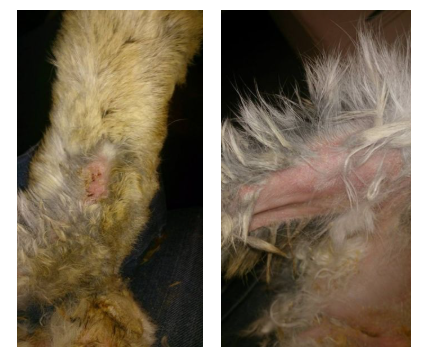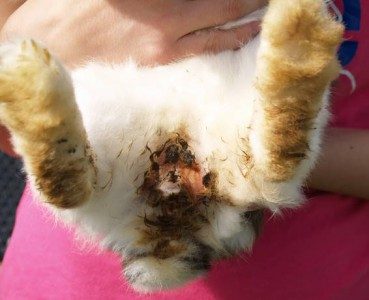Dermatitis
Attention! Rabbits that wet themselves or have wounds or skin inflammation are at high risk of flystrike! They should be brought indoors, protected with fly screens, frequent checks, and a fly-repellent spot-on treatment! Learn more about it.
Symptoms: How to Recognize a Skin Inflammation?
Skin inflammations usually occur secondarily due to heavily stressed skin (e.g., from wetness, frequent washing of the hind area, matting, or diarrhea), fungal infections, or parasite infestations. The skin becomes red, fur falls out, and inflammatory crusts or white-yellowish coatings (fibrin), sometimes resembling dandruff, can be seen. The rabbit may have an unpleasant odor, and the affected areas are painful.

When Should I See a Vet?
Skin inflammations are extremely painful, so you should not hesitate to make a veterinary appointment. Since each case is different, a vet can best determine the ideal treatment for your rabbit. Additionally, they will prescribe necessary pain medication.
Treatment: What Helps?
A veterinarian will prescribe an anti-inflammatory pain reliever and, in severe cases, an antibiotic. They will also provide guidance on how to care for the inflamed area.
Home Care & Supportive Treatment
- Zinc ointment and baby powder have shown good results.
- Thoroughly clean the affected area with warm water (preferably using mallow tea).
- Gently comb and dry the fur using a slicker brush and flea comb to restore its fluffiness, ensuring it forms a protective barrier for the skin.
- Apply a thin layer of zinc ointment to the inflamed/red skin for 3–5 consecutive days, avoiding excessive contact with surrounding fur. If the area is healing well, baby powder can be used instead.
- Improvement is often visible within a day, with fibrin deposits disappearing after 2–4 days.
Preventing Further Irritation
- Use highly absorbent bedding (e.g., wood pellets) topped with straw or hay to keep the area dry, especially for rabbits that sit frequently due to illness.
- Maintaining the fur is crucial as it protects the skin from urine. After cleaning, always ensure the fur is properly fluffed rather than shaving it.
Address the Underlying Cause!
To prevent further inflammation, it is essential to identify and resolve the underlying issue. More information on potential causes can be found here





















